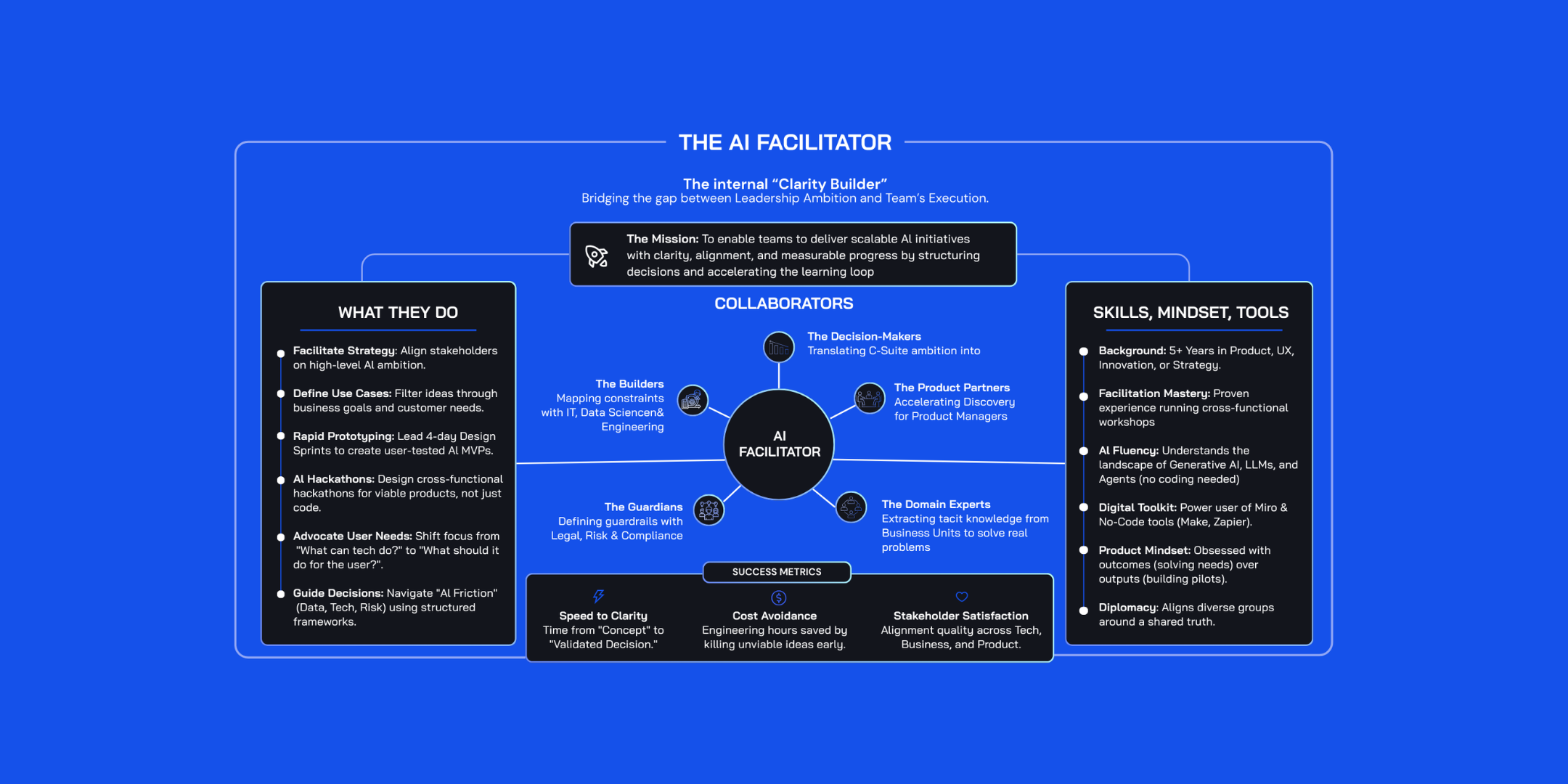Design Sprints - A Shortcut to Becoming a Human-Centered Organization

Human-centered organizations generate higher revenues, deliver outcomes 2x faster to market than traditional companies, and ultimately outperform the S&P 500 by 211%. Results like these convince more and more organizations to embark on the human-centricity journey. But then they struggle to structurally shift their values to customers/users and reach their desired outcomes.
When you research human-centered organizations, you probably come across Design Thinking and its many definitions: an idea, a mindset, a method, a strategy, a way of seeing the world, a “way to solve problems through creativity,” according to IDEO. But regardless of how you and I define it, Design Thinking puts the human at its core and uses the power of collaboration to bring together what is desirable from a human point of view with what is feasible and economically viable.
There are many variants of the Design Thinking process in use today, yet they all embody the same principles:
- Empathize — with your customers
- Define — your customer’s needs and your insights
- Ideate — possible solutions by challenging assumptions and the status quo
- Prototype — realistic facades of how your solution would work
- Test — your prototypes with your customers and learn what works and what doesn’t.
Design Thinking and the concept of human-centricity have been embraced over the past 30 years by many organizations across the globe, such as Apple, Coca-Cola, IBM, Nike, Procter & Gamble. Those organizations became successful at solving problems, innovating, and creating beyond form and function. According to a 2016 report from the Design Management Institute, design-driven companies outperformed their competitors by an accumulated 211% in what’s called the Design Value Index (a portfolio of 16 publicly traded companies that integrate Design Thinking into their corporate strategy) over the past ten years.

This shows that design-driven organizations can create and change markets by understanding, attracting, and interacting with their customers better than their competitors. They have the potential to drive markets rather than adapt to them.
As you can probably imagine becoming a design-driven organization or integrating Design Thinking into a company DNA is not an easy journey. There’s no need to downplay the difficulty of such endeavor as it requires seamlessly streamlining people, processes, technology, and funding. Adopting Design Thinking as a way of working mandates an organization to transform its structure and demands a significant change of purpose, mindsets, and behaviors.
So, let’s take a closer look at the barriers that slow down the adoption of Design Thinking in large organizations and how its strengths can become weaknesses when not addressed the right way at the right time.
As an open, non-linear process, Design Thinking takes a long time.
As a method, Design Thinking is not a linear, fixed process. One can jump from one phase to another without necessarily following a straight path, as each stage is designed to be iterative and cyclical. For example, you might build and test a prototype and then return to the Empathize and Define phases to refine and correct your data and insights. You might also repeat some stages to arrive at the needed outcome. It’s also not uncommon to spend an extended amount of time in the Define phase to align a team to the same direction, especially if there are obstacles in securing buy-in.
🚧 This very flexibility, though, can be a double-edged sword, particularly in the context of large organizations. The open-ended, adaptable nature of Design Thinking means that it's not a quick-fix solution. Projects can extend over a lengthy period, from weeks to months, and in some scenarios, even years. This time commitment can make swift adoption challenging in large-scale corporate environments where agility and rapid implementation are often prioritized.
As a user-centered approach, Design Thinking requires built-in structures.
Design Thinking puts the human at its core, so it is only natural for any project to start and evolve around customer data, meaning that:
- points of contact with real customers must be created;
- customer insights need to be collected, synthesized, and disseminated across the organization;
- relationships with customers need to be maintained and nourished;
- customers need to be involved in the co-creation process;
- different departments own the interaction with the customers at various touchpoints.
🚧 The corresponding processes, structures, roles, and systems must be re-envisioned for an organization to stay close to its customers. And this transformation requires the willingness to change the status quo, tear down departmental boundaries, and stakeholder support.
As a cluster of approaches and tools, Design Thinking calls for mastery.
Another strength that could quickly become a weakness is its versatility.
In Design Thinking, you have many methods, exercises, and approaches to help you complete each phase. While this gives you many options, it can also lead you astray. You might lose focus, not always know where to look, or you might not even have enough expertise to pick the best method for a specific scenario.
🚧 Design Thinking requires skills, proper knowledge, and effective playbooks. That’s why you can’t become a design thinker overnight.
What if you could instil a growth mindset, collaborate effectively across disciplines, and spark innovative ideas faster without wasting time, radically restructuring, or losing yourself in the process?
Introducing Problem Framing & Design Sprints
your shortcut to becoming a human-centered organization!
Problem Framing and Design Sprints are repetitive, fast, easy to implement, and scalable frameworks.
Design Sprints started at Google ten years ago to help googlers collaborate efficiently and validate concepts fast. They became popular in 2016 with the publishing of the NY best-selling book — “Sprint” by Jake Knapp.
Design Sprints are a five-day process for answering critical business questions through design, prototyping, and testing ideas with customers.
If you fast forward into the future, you will discover different adaptations for this approach as it became globally adopted by organizations big and small across industries.
As we primarily work with fortune 500 and large organizations, we needed to develop the sprint method (initially designed to help startups launch better products) to fit more complex organizational structures, needs, and constraints. Each corporate design sprint project at Design Sprint Academy starts with Problem Framing.
Problem Framing is a design thinking method used by a group of senior decision-makers to understand, define and prioritize complex business problems in just one day.
In Problem Framing, we extract the best parts of the Empathize and Define phases from Design Thinking to provide senior stakeholders with a holistic view of the problems grounded in real customer insights. We then double down on their decision-making expertise and individual perspectives to re-frame, define and prioritize business problems.
Through Problem Framing, we ensure that an organization focuses only on opportunities worth the investment, aligned with the business goals, and with proper stakeholder support.
Now that the scope is well defined, a qualified cross-functional team of experts will progress from problem to customer-tested solutions by following a predefined sequence of activities.
But let’s see why Design Sprints are more practical than Design Thinking regarding problem-solving, solution validation, and effective collaboration.
Three reasons why design sprints are your shortcut to becoming a human-centered organization
1. Small wins
Design Thinking can get very large in scope and tackle complex challenges that involve multiple stakeholders and audiences. Design Sprints work best when the scope is narrower, there’s a sense of urgency, and the problems to be solved have clearly defined boundaries.
Design Thinking works best for a challenge such as:
- How might our organization become carbon-neutral by 2023?
- Design Sprints work best for a more specific challenge:
- How might we empower our employees to eat more sustainably and reduce food waste?
Because of their narrow scope, Design Sprints can generate the tangible “small wins” any large organization needs to fuel sustainable change. The compound effect of small wins can be more significant than a big win obtained with tremendous effort.

2. Speed
Time is scope-bound. The larger the project scope, the bigger the timeline. As Design Thinking tackles more broadly scoped projects, it’s only natural it would take a lot more time (weeks to months, sometimes years) to get to the desired outcomes.
Design Sprints, on the other hand, are time-boxed. A design sprint would take four days in an in-person format and five days in a virtual setup. Just as well, the duration of a Problem Framing workshop is anywhere between six hours to one and a half days.
Design Sprints are, after all, sprints. Their speed in delivering customer-tested prototypes makes them easy to add to existing processes and workflows.

3. Simplicity
Design Thinking is a complex and versatile framework comprising many tools and methods for each phase. Complexity calls for expertise.
Design Sprints are the complete opposite. Instead of a plethora of tools, methods, and approaches, the sprint framework relies on specific, clear, and easy exercises for each phase.
Because of their scripted sequence of exercises, design sprints are easier to understand and put into practice by diverse teams.

Conclusion
So, here you go, three reasons why design sprints are more practical and easier to start with if you plan to become a human-centered organization or improve the way of working and collaborating within your teams.
It’s your shortcut from design thinking to design doing!



.jpg)





